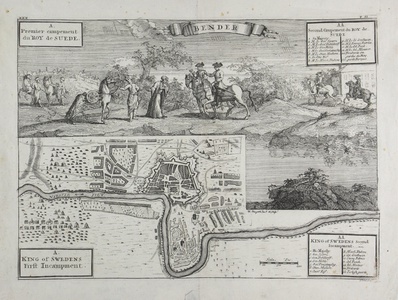| Method | Etching |
| Artist | William Hogarth and Samuel Parker |
| Published | w. Hogarth Invt. et Sculpt. / S. Parker Sculpt. [1723] |
| Dimensions | Image 245 x 350 mm, Plate 260 x 352 mm, Sheet 340 x 405 mm |
| Notes |
A first state printing of one of Hogarth's earliest works, a plate from Aubry de la Motraye's Travels through Europe, Asia, and into Part of Africa depicting the encampment of the army under Charles XII, King of Sweden at the Turkish fortress of Bender on the Dneister River, in modern day Transnistria (Moldova). The plate is divided in two, with the scene above by Hogarth and the map of Bender below engraved by Samuel Parker. In the vignette, the King and the Minister for Holstein, Baron de Fabrice, are shown on horseback, accompanied by a retinue of Janissaries given them by the Ottoman Sultan Ahmed III. The walls of the fortress of Bender can be seen in the distance to the left of the scene. The map below emphasised the strategic importance of the fortress, and its significant defensive capabilities. A set of numerical keys in the corners of the sheet provide details of the positions of the King, his commanders, and the Swedish troops. Hogarth's plate of Bender was the only one in the series of engravings for Motraye's Travels to bear his name. On stylistic grounds, Paulson includes a further fourteen from the series as likely to have been Hogarth's work. Charles XII's defeat by Russian forces under Peter I at the Battle of Poltava in 1709 left him and his army stranded in Ottoman territory, where the Swedes were given a relatively warm reception by Sultan Ahmed III. In the following year, Ahmed was encouraged to go to war against the Empire's northern rival, gaining significant successes against Russia and leaving Moscow open to the Turks, who were only prevented from further restricting Russian influence by an untimely invasion by the Safavids on the Persian borders of the Ottoman empire. William Hogarth (1697 - 1764) was born in London, the son of an unsuccessful schoolmaster and writer from Westmoreland. After apprenticeship to a goldsmith, he began to produce his own engraved designs in about 1710. He later took up oil painting, starting with small portrait groups called conversation pieces. He went on to create a series of paintings satirising contemporary customs, but based on earlier Italian prints, of which the first was The Harlot's Progress (1731), and perhaps the most famous The Rake's Progress. His engravings were so plagiarised that he lobbied for the Copyright Act of 1735, commonly referred to as 'Hogarth's Act,' as a protection for writers and artists. During the 1730s Hogarth also developed into an original painter of life-sized portraits, and created the first of several history paintings in the grand manner. Samuel Parker (c.1696-1728) was a British engraver and mapmaker, best known for engraving plates for John Senex, Thomas Badeslade, Nathaniel Cutler, and the Knaptons. Paulson 37 i/ii Condition: Central vertical fold, as issued. Repaired tear to bottom of central fold, not affecting plate. Time toning, foxing, and creasing to margins. Short tears to edges of sheet. Blank on verso. |
| Framing | unmounted |
| Price | £400.00 |
| Stock ID | 50697 |

